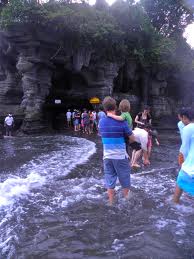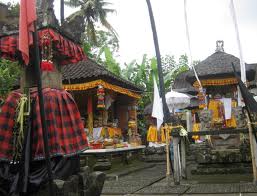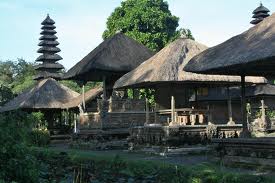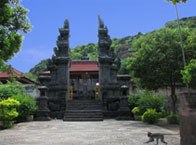
BALINESE HINDU TEMPLES
GOA LAWAH TEMPLE
The Goa Lawah temple is situated on a slight embankment and the name is derived from the thousands of bats that are living at the ceiling and walls of the cave
.jpg) This is a very popular tourist attraction and the government protects the bats so that nobody can disturb them. There is also a beautiful beach south of the cave, which is dotted with huts, built by people who make salt in the traditional way. You can also see Nusa Penida island from this spot. In the 17th century the temple was used as a place of worship by the king of Klungkung and Goa Lawah was also used to test the innocence of people found guilty of breaking the law.
This is a very popular tourist attraction and the government protects the bats so that nobody can disturb them. There is also a beautiful beach south of the cave, which is dotted with huts, built by people who make salt in the traditional way. You can also see Nusa Penida island from this spot. In the 17th century the temple was used as a place of worship by the king of Klungkung and Goa Lawah was also used to test the innocence of people found guilty of breaking the law.
There were nine kingdoms in Bali in the 17th century each possessing autonomous power. But the King of Klungkung was respected and recognized as the highest king. When within the kingdom of Mengwi, a dispute ensued between the king's descendants, I Gusti Ngurah Made Agung and I Gusti Ketut Agung. The latter was not accepted as the descendant of the King of Mengwi. He was delivered to be tried by the King of Klungkung. The King of Klungkung decided that I Gusti Ketut Agung be ordered to enter Goa Lawah, if he came out alive he would be recognized as a descendant. The cave at that time also housed, as well as bats, big snakes and other wild animals. According to history I Gusti Ketut Agung accepted the sentence, entered the cave and finally emerged at Besakih.
True to the judgment of the King of Klungkung, he was recognized as a member of the King of Mengwi's family. When he became a King he was known as I Gusti Ketut Agung Besakih. The records also said that as a result of entering the cave he became deaf. The snakes and other wild animals no longer inhabit the cave, but thousands of bats that remain create a unique and popular attraction. Goa Lawah is on the main road from Denpasar to Candidasa, approximately 50 Kms from Denpasar.
TANAH LOT TEMPLE
In the story of Dang Hyang Nirartha (a Hindu high priest), when he traveled around Bali, he came upon tanah lot which is located in tabanan and here, he decided to stay the night. It is said that this very important priest came to bali in about 1411 according to the balinese icaka calendar, or 1489 AD by the western calendar.

After pending some time in the temple of Siva's Hair, he moved on going further east. The esteemed priest and his devoted followers followed the southern coastline of Ball on their journey. For the entire trip along the shores of Bali, he was accompanied by the sound of the crashing waves in his ears and the sharp breeze penetrating his body. It was through this closeness with nature that, he thought of the power of God and God's power to create all of nature and all the contents of the world. It also occurred to him that, as God had created humankind, humans should give thanks and pay respect to God. The priest Dang Hyang Nirartha always carried a special carving knife, with which he could carve Inscriptions and notes on the long "lontar" palm slabs, and wrote what he saw, felt or thought of as important.
The recordings were made in verse form. This priest was such a great man, that when he was totally involved in something. he forgot about all else and never tired in his journey. His feet virtually floated above the ground he traversed. It wasn't long before he arrived at a small Island almost, Joined to the shore that was made of coral. Here he stopped a moment to rest. The people here were all fishermen and they gathered together to pay their respects. The fishermen wanted Dang Hyang Nirartha to stay at their modest homes, but he refused their invitation. He wanted to spend the night on the small island because the air was cool and fresh. He also had a wonderful view from this vantage point.
That evening before he retired for the night, he was able to teach the people who came to see him moral ethics, religion and welfare. Dang Hyang Nirartha advised the people at this time to build a Parhyangan (temple) at this place where he had chosen to stay for the night. Because of the feeling this holy man felt in his inner soul, and other strange, mysterious and miraculous happenings that occurred there, the priest knew that this was the right place to praise God (Sanghyang Widhi Wasa). From there on the Balinese would have a place at which they could praise God and request salvation and safety for the world.
When Dang Hyang Nirartha finally left this place, the people with whom he had spoken, indeed built the holy temple and gave it the name "Pura Pakendungan" which nowadays is better known as "Tanahlot". This temple is well know throughout not only Indonesia, but the entire world. Why is this temple one of the favorite tourist attractions for people from around the world ? You should go and see for yourself - it is beautiful and unique. You will have to arrange to travel 31 Km from Denpasar and that will take about an hour. Ran port is no problem as tourist buses go there all the time if you won't have some other private transport arrangement.
The best time to see it is in the afternoon when the sun setting in he west splits the shore line in half along a north-south axis. His spectacle will live on long in your memory. There is a religious ceremony coming up on the 7th of August 1996. The atmosphere will be even further enhanced as the Balinese Hindus in their ceremonial rests go to the temple to pray.
SAKENAN TEMPLE
Serangan Island is a small island located across the southern coast of the Island of Ball. The Island Is part of
Badung Regency.
At the south-western tip of the island, exactly on the beach is a holy structure known as Pura Sakenan. This temple is estimated to have been established in the 16th century and is connected with the journey of Dang' Hyang Nirartha, a great priest who purified the Hindu religion in Bali.
In the western part of the Sakenan Temple grounds is a holy structure called Pura Dalem Sakenan which holds an ancient heritage called 'persada or candi' meaning monument made of coral stone with very attractive motifs for ifs relief. The motifs are quite different than those found in the existing buildings. The temple is exactly at the edge of the coastline and surrounded by sea. In the eastern part of Serangan island is another ancient temple called Pura Cemara.
 The temple grounds holds another holy structure called Gedong Cemara with a strange architecture and quite different from those found in Bali.
The temple grounds holds another holy structure called Gedong Cemara with a strange architecture and quite different from those found in Bali.
Apart from the magnificent sea view, there is something unique to be noted in that there are two groups of inhabitants of a different faith. One is of the Hindu faith and the other is Moslems. Never the less, they live peacefully and harmoniously, helping one another in the traditional 'gotong royong' spirit, meaning assisting one another without any intention of receiving a reward. The monuments or candi has a multi-tiered roofing and towers into the sky.
Denpasar to the south via Sesetan village to Pegok village. Turn to the right until you find 'Suwung Batan Kendal' village. It is accessible by car. From there you can continue your journey either on foot at low tide walking on a The monument or 'candi' reminds us to an assimilation of standard monuments and those found In East Java, which are multi-tiered from the pre-historic era. The gate is made of coral stone alike the one found in the Uluwatu Temple. Outside the walls there is a statue of a giant and there is also a Ganeca type statue, a symbol of Dewa Kala as the guardian of the temple.
The island of Serangan is about 10 km from bed of coral stones, or by proa at high tide to cover a distance of about 1 km to the Sakenan Temple. Have a nice trip !
TAMAN AYUN TEMPLE
The temple of Taman Ayun, in Bali's Mengwi district, has long been known as a well-frequented tourist spot. This temple is classified as the central temple of the kingdom, while according to the genealogical investigations, it is one that for ancestor worship that deviates in form from the temples of Pangelengan temple, Bukit Bon temple, Sakenan temple, Uluwatu temple, Sada temple and other similar ones.

The name of the temple "Taman Ayun" means beautiful garden, and we know that I Gusti Agung Anom, a founder of the Mengwi kingdom in 1634, established the temple. We know also that the temple and grounds were skillfully restored and renovated in later years, giving it the present appearance which tourists find so attractive and interesting. Actually built on a fairly high tableland site, which is surrounded by lotus ponds, the temple's position if seen from a far, is as if it's floating on the surface of the water. The temple faces south, on its eastern side is one of the main roads to Denpasar (the road that passes through Bedugul on its way to Singaraja), in front of the temple is a road that joins up with the road to the Sangeh Monkey Forest. A birds-eye view of the temple would reveal an open stage which functions as a place for Balinese cultural performances.There are many interesting features of both the temple its self, as well as' the area of the grounds. Many people visit this temple because its an ideal recreation garden, the air is cool and the place has a calm tranquil feeling about it. The still waters provide a safe protected environment for all sorts of aquatic life, which live in the ponds. The temple complex comprises of three ground areas, which rise in levels. In the most external one to the complex, is the "bale wantilan" (a general purpose hall), this place is used for all sorts of events, religious ceremonies, as well as for staging performances and for cock fighting. To the west there is a decorative fountain with water pouring down all around it. Building called Padma Sana, the temple and others. The central section is surrounded by a small pond, this the complete section of the temple is symbolical of the great Mandhara Mountain (Mandhara Giri), turning in a sea of milk. The temple buildings are filled with interesting decorations and relief's Because of the fairly recent restoration in 1937. As previously mentioned. The building, are not of the old style. This tourist attraction is not difficult to find, it's about 18 km from Denpasar, on the road that goes to Singaraja via Bedugul.
The Mengwi crossroads is just before the. road starts the long climb upwards towards Bedugul, and it is at this crossroads that you must turn right (assuming, In the central grounds is a building called the "bale pelik", it is beautifully carved with interesting relief's and statues of the nine gods ("Dewa Nawa Sanga"). In the innermost courtyard there are 29 buildings, which function as palaces for the gods and goddesses, as well as other buildings, which house religious regalia used in ceremonies. This is also the case with the multi roofed structures, (some of them having up toll of these special roofs called "meru meru"), of course, that you are coming up from Denpasar). The temple and its large grounds will be found on your left, very close to the crossroads. There is temple parking for all types of transport. To offer some further information, each afternoon a show is held at the temple of Taman Ayun. There you can see the Barong dance, a cockfight and see and hear the playing of the Balinese "Tektekan" a bamboo percussion instrument).
 |
PULAKI TEMPLE
Pulaki temple is a Hindu shrine located in the hill bank and in front of the beautiful beach in north part of Bali. It is one of the biggest Hindu temples in Bali situated in the coastal side west part of Singaraja town or 1 hour drive to the west from the town. This temple is set on the flat land with stone hill bank as a back drop meanwhile the blue ocean is just in front of the temple.It is located in Pulaki Village, Seririt Sub District, Singaraja Regency, north part of Bali. It is just 3 hours drive from Bali's International Airport or 1 hour drive from Singaraja town. It is strategically set in the main road from Singaraja to Gilimanuk with the group of monkeys as the identity for the traveler who wants to visit this temple.
|
|